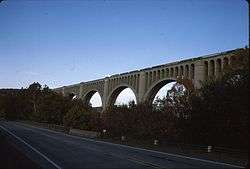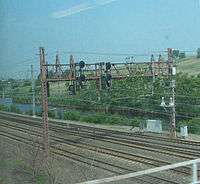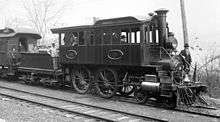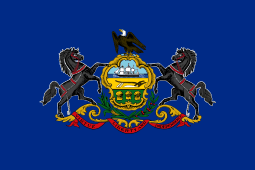Delaware, Lackawanna and Western Railroad
 | |
|
DL&W system map, circa 1922 | |
| Reporting mark | DLW |
|---|---|
| Locale |
Pennsylvania New York New Jersey |
| Dates of operation | 1851–1960 |
| Successor | Erie Lackawanna Railroad |
| Track gauge | 4 ft 8 1⁄2 in (1,435 mm) standard gauge |
| Previous gauge | 6 ft (1,829 mm) |
| Length | 998 miles (1,606 kilometers) |
| Headquarters | New York City, New York |
The Delaware, Lackawanna & Western Railroad Company (DL&W or Lackawanna Railroad) was a U.S. Class 1 railroad that connected Buffalo, New York, and Hoboken, New Jersey, a distance of about 400 miles (640 km). Incorporated in 1853, the DL&W was profitable during the first two decades of the twentieth century, but its margins were gradually hurt by declining traffic in coal and competition from trucks. In 1960, the DL&W merged with rival Erie Railroad to form the Erie Lackawanna Railroad.
History
Pre-DL&W (1832–1853)

The Liggett's Gap Railroad was incorporated on April 7, 1832, but stayed dormant for many years. It was chartered on March 14, 1849, and organized January 2, 1850. On April 14, 1851, its name was changed to the Lackawanna and Western Railroad. The line, running north from Scranton, Pennsylvania, to Great Bend, just south of the New York state line, opened on December 20, 1851. From Great Bend the L&W obtained trackage rights north and west over the New York and Erie Rail Road to Owego, New York, where it leased the Cayuga and Susquehanna Railroad to Ithaca on Cayuga Lake (on April 21, 1855). The C&S was a re-organized and partially re-built Ithaca and Owego Railroad, which had opened on April 1, 1834, and was the oldest part of the DL&W system. The whole system was built to 6 ft (1,829 mm) broad gauge, the same as the New York and Erie, although the original I&O was built to standard gauge and converted to wide gauge when re-built as the C&S.
The Delaware and Cobb's Gap Railroad was chartered December 4, 1850, to build a line from Scranton east to the Delaware River. Before it opened, the Delaware and Cobb's Gap and Lackawanna and Western were consolidated by the Lackawanna Steel Company into one company, the Delaware, Lackawanna and Western Railroad, on March 11, 1853. On the New Jersey side of the Delaware River, the Warren Railroad was chartered February 12, 1851, to continue from the bridge over the river southeast to Hampton on the Central Railroad of New Jersey. That section got its name from Warren County, the county through which it would primarily run.
Expansion and profits (1853–1940)


The rest of the line, now known as the Southern Division, opened on May 27, 1856, including the New Jersey section (the Warren Railroad). A third rail was added to the standard gauge Central Railroad of New Jersey east of Hampton to allow the DL&W to run east to Elizabeth via trackage rights (the CNJ was extended in 1864 to Jersey City).
On December 10, 1868, the DL&W bought the Morris and Essex Railroad. This line ran east-west across northern New Jersey, crossing the Warren Railroad at Washington and providing access to Jersey City without depending on the CNJ. The M&E tunnel under Bergen Hill opened in 1876, also relieving it of its use of the New York, Lake Erie and Western Railway in Jersey City. Along with the M&E lease came several branch lines in New Jersey, including the Boonton Line (opened in 1870), which bypassed Newark for through freight.

The DL&W bought the Syracuse, Binghamton and New York Railroad in 1869 and leased the Oswego and Syracuse Railroad on February 13, 1869. This gave it a branch from Binghamton north and northwest via Syracuse to Oswego, a port on Lake Ontario. The Greene Railroad was organized in 1869, opened in 1870, and was immediately leased to the DL&W, providing a short branch off the Oswego line from Chenango Forks to Greene. Also in 1870 the DL&W leased the Utica, Chenango and Susquehanna Valley Railway, continuing this branch north to Utica, with a branch from Richfield Junction to Richfield Springs (fully opened in 1872).
The Valley Railroad was organized March 3, 1869, to connect the end of the original line at Great Bend, Pennsylvania to Binghamton, New York, avoiding reliance on the Erie. The new line opened October 1, 1871. By 1873, the DL&W controlled the Lackawanna and Bloomsburg Railroad, a branch from Scranton southwest to Northumberland (with trackage rights over the Pennsylvania Railroad's Northern Central Railway to Sunbury). On March 15, 1876, the whole system was re-gauged to standard gauge in one day. The New York, Lackawanna and Western Railroad was chartered August 26, 1880, and opened September 17, 1882, to continue the DL&W from Binghamton west and northwest to Buffalo. The main line ran to the International Bridge to Ontario, and a branch served downtown Buffalo. On December 1, 1903, the DL&W began operating the Erie and Central New York Railroad, a branch of the Oswego line from Cortland Junction east to Cincinnatus. By 1909, the DL&W controlled the Bangor and Portland Railway. This line branched from the main line at Portland, Pennsylvania southwest to Nazareth, with a branch to Martins Creek.
New terminals and realignments
The DL&W built a Beaux-Arts terminal in Hoboken in 1907, and another Beaux-Arts passenger station (now a Radisson hotel) in Scranton the following year.

The Lackawanna Railroad of New Jersey, chartered on February 7, 1908, to build the Lackawanna Cut-Off (a.k.a. New Jersey Cutoff or Hopatcong-Slateford Cutoff), opened on December 24, 1911. This provided a low-grade cutoff in northwestern New Jersey. The cutoff included the Delaware River Viaduct and the Paulinskill Viaduct, as well as three concrete towers at Port Morris and Greendell in New Jersey and Slateford Junction in Pennsylvania. From 1912 to 1915, the Summit-Hallstead Cutoff (a.k.a. Pennsylvania Cutoff or Nicholson Cutoff) was built to revamp a winding and hilly system between Clarks Summit, Pennsylvania, and Hallstead, Pennsylvania. This rerouting provided another quicker low-grade line between Scranton and Binghamton. The Summit Cut-Off included the massive Tunkhannock Viaduct and Martins Creek Viaduct. The Lackawanna's cutoffs had no at-grade crossings with roads or highways, allowing high-speed service.
Decline (1940–1960)
The most profitable commodity shipped by the railroad was anthracite coal. In 1890 and during 1920–1940, the DL&W shipped upwards of 14% of the state of Pennsylvania's anthracite production. Other profitable freight included dairy products, cattle, lumber, cement, steel, and grain.[1] The Pocono Mountains region was one of the most popular vacation destinations in the country—especially among New Yorkers—and several large hotels sat along the line in Northeastern Pennsylvania, generating a large passenger traffic for the Lackawanna. All of this helped justify the railroad's expansion of its double-track mainline to three and in a few places four tracks.[1]
| Year | Traffic |
|---|---|
| 1925 | 4588 |
| 1933 | 2498 |
| 1944 | 5822 |
| 1960 | 2580 thru 16 Oct |
| Year | Traffic |
|---|---|
| 1925 | 671 |
| 1933 | 428 |
| 1944 | 623 |
| 1960 | 226 thru 16 Oct |
Changes in the region's economy undercut the railroad, however. The post-World War II boom enjoyed by many U.S. cities bypassed Scranton and the rest of Lackawanna and Luzerne counties. Oil and natural gas quickly became the preferred energy sources. Silk and other textile industries shrank as jobs moved to the southern U.S. or overseas. The advent of refrigeration squeezed the business from ice ponds on top of the Poconos. Even the dairy industry changed. The Lackawanna had long enjoyed revenues from milk shipments; many stations had a creamery next to the tracks.
Perhaps the most catastrophic blow to the Lackawanna, however, was dealt by Mother Nature. In August 1955, flooding from Hurricane Diane devastated the Pocono Mountains region, killing 80 people. Hurricane Diane also caused the DL&W to abandon their Old Road/former Warren Railroad line due to severe damages that simply wouldn't be worth it to repair. The floods cut the Lackawanna Railroad in 88 places, destroying 60 miles (97 km) of track, stranding several trains (with a number of passengers aboard), and shutting down the railroad for nearly a month (with temporary speed restrictions prevailing on the damaged sections of railroad for months), causing a total of $8.1 million in damages (equal to $71,672,422 today) and lost revenue. Until the mainline in Pennsylvania reopened, all trains were cancelled or rerouted over other railroads. The Lackawanna would never fully recover.[1]
In January, 1959, the final nail in the Lackawanna's coffin was driven home when the Knox Mine Disaster flooded the mines along the Susquehanna River and all but obliterated what was left of the region's anthracite industry.[2][3]
The Lackawanna Railroad's financial problems were not unique. Rail traffic in the U.S. in general declined after World War II as trucks and automobiles took freight and passenger traffic.[1] Declining freight traffic put the nearby New York, Ontario and Western Railroad and Lehigh & New England Railroad out of business in 1957 and 1961, respectively. Over the next three decades, nearly every major railroad in the Northeastern US would go bankrupt.
Erie merger and aftermath (1956–present)
- Erie Lackawanna

In the wake of Hurricane Diane in 1955, all signs pointed to continued financial decline and eventual bankruptcy for the DL&W. Among other factors, property taxes in New Jersey were a tremendous financial drain on the Lackawanna and other railroads that ran through the state, a situation that would not be remedied for another two decades.[1]
To save his company, Lackawanna president, Perry Shoemaker, sought a merger with the Nickel Plate Road, a deal that would have created a railroad stretching more than 1,100 miles (1,800 km) from St. Louis, Missouri, to New York City and would have allowed the Lackawanna to retain the 200 miles (320 km) of double-track mainline between Buffalo and Binghamton, New York. The idea had been studied as early as 1920, when William Z. Ripley, a professor of political economics at Harvard University, reported that a merger would have benefited both railroads.[4] Forty years later, however, the Lackawanna was a shadow of its former financial self. Seeing no advantage in an end-to-end merger, Nickel Plate officials also rebuffed attempts by the DL&W, which owned a substantial block of Nickel Plate stock, to place one of its directors on the Nickel Plate board. (The Nickel Plate would later merge with the Norfolk and Western Railroad.)
Shoemaker next turned, in 1956, to aggressive, but unsuccessful, efforts to obtain joint operating agreements and even potential mergers with the Lehigh Valley Railroad and the Delaware and Hudson Railway.
Finally, Shoemaker sought and won a merger agreement with the Erie Railroad, the DL&W's longtime rival (and closest geographical competitor).
The merger was formally consummated on October 17, 1960. Shoemaker drew much criticism for it, and would even second-guess himself after he had retired from railroading. He later claimed to have had a "gentlemen's agreement" with the E-L board of directors to take over as president of the new railroad. After he was pushed aside in favor of Erie managers, however, he left in disillusionment and became the president of the Central Railroad of New Jersey in 1962.[1]

Even before the formal merger, it led to the abandonment of most of the Lackawanna's mainline trackage between Binghamton and Buffalo. In 1958, the main line of the DL&W from Binghamton west to near Corning, which closely paralleled the Erie's main line, was abandoned in favor of joint operations, while the Lackawanna Cut-Off in New Jersey was single-tracked in anticipation of the upcoming merger. On the other hand, the Erie's Buffalo, New York and Erie Railroad was dropped from Corning to Livonia in favor of the DL&W's main line. Most passenger service was routed onto the DL&W east of Binghamton, with the DL&W's Hoboken Terminal serving all E-L passenger trains. In addition, a short segment of the Boonton Branch by Garret Mountain in Paterson, New Jersey, was sold off to the state of New Jersey to build Interstate 80. Ultimately, the west end of the Boonton Branch was combined with the Erie's Greenwood Lake Branch, while the eastern end was combined with the Erie's Main Line, which was abandoned through Passaic, New Jersey. Sacrificed was the Boonton Branch: a high-speed freight line thought to be redundant with the Erie's mainline. This would haunt E-L management less than a decade later (and Conrail management a decade after that).

Soon after the merger, the new E-L management shifted most freight trains to the "Erie side", the former Erie Railroad lines, leaving only a couple of daily freight trains traveling over the Lackawanna side. Passenger train traffic would not be affected, at least not immediately. This traffic pattern would remain in effect for more than ten years—past the discontinuation of passenger service on January 6, 1970—and was completely dependent on the lucrative interchange with the New Haven Railroad at Maybrook, New York. The 1970 merger of the New Haven Railroad into the Penn Central Railroad changed all this: the New England Gateway was closed, causing dramatic traffic changes for the Lackawanna side. Indeed, as very little on-line freight originated on the Erie side (a route that was more than 20 miles longer than the DL&W route to Binghamton), once the Gateway was closed (eliminating the original justification for shifting traffic to the Erie side), virtually all the E-L's freight trains were shifted back to the Lackawanna side. After the New England Gateway closed, E-L's management was forced to downgrade the Erie side, and even considered its abandonment west of Port Jervis. In the meantime, the E-L was forced to run its long freights over the reconfigured Boonton Line, which east of Mountain View in Wayne, NJ meant running over the Erie's Greenwood Lake Branch, a line that was never intended to carry the level of freight traffic to which the E-L would subject it.
In 1972, the Central Railroad of New Jersey abandoned all its operations in Pennsylvania (which by that time were freight-only), causing additional through freights to be run daily between Elizabeth, NJ on the CNJ and Scranton on the E-L. The trains, designated as the eastbound SE-98 and the westbound ES-99, travelled via the Lackawanna Cut-Off and were routed via the CNJ's High Bridge Branch. This arrangement ended with the creation of Conrail.[6]
During its time, the E-L diversified its shipments from the growing Lehigh Valley and also procured a lucrative contract with Chrysler to ship auto components from Mount Pocono, Pennsylvania. The E-L also aggressively sought other contracts with suppliers in the area, pioneering what came to be known as intermodal shipping. None of this could compensate for the decline in coal shipments, however, and as labor costs and taxes rose, the railroad's financial position became increasingly precarious although it was stronger than some railroads in the eastern U.S.
The opening of Interstates I-80, I-380, and I-81 during the early 1970s, which in effect paralleled much of the former Lackawanna mainline east of Binghamton, New York, caused more traffic to be diverted to trucks. This only helped to accelerate the E-L's decline and its inclusion into Conrail, a new regional railroad that was created on April 1, 1976, out of the remnants of seven bankrupt freight railroads in the northeastern U.S.
- Conrail
The E-L was legally conveyed into Conrail on April 1, 1976. Initially, Conrail's freight schedule did not change much from the E-L's due to labor contracts that restricted any immediate alterations. This, too, would change. In early 1979, Conrail suspended through freight service on the Lackawanna side, citing the E-L's early-1960s severing of the Boonton Branch near Paterson, New Jersey, and the grades over the Pocono Mountains as the primary reason for removing freight traffic from the entire Hoboken-Binghamton mainline and consolidating this service within its other operating routes.

The busy Morristown Line is the only piece of multi-track railroad on the entire 900-mile Lackawanna system that has not been reduced to fewer tracks over the years. In the 1986 photograph to the right, a set of Arrow III single units and an Arrow II married pair runs eastbound after passing the NJ Transit station in South Orange, New Jersey. The line was triple-tracked nearly a century prior, and remains so today.
The Lackawanna Cut-Off was abandoned in 1979 and its rails were removed in 1984. The line between Slateford Junction and Scranton remained in legal limbo for nearly a decade, but was eventually purchased, with a single track left in place. The Lackawanna Cut-Off's right-of-way, on the other hand, was purchased by the state of New Jersey in 2001 from funds approved within a $40 million bond issue in 1989. (A court later set the final price at $21 million, paid to owner Gerald Turco of Kearny, New Jersey.) NJ Transit has estimated it would cost $551 million to restore service to Scranton over the Cut-Off, a price which includes the cost of new trainsets. A 7.3-mile section of the Cut-Off between Port Morris and Andover, NJ, however, is currently under construction and is slated to re-open for rail passenger service in 2014.
- Delaware and Hudson (Canadian Pacific)
In 1979, Conrail sold most of the DL&W in Pennsylvania, with the portion between Scranton and Binghamton bought by the Delaware and Hudson Railway. The D&H was absorbed into the Canadian Pacific Railway in 1991. CPR continued to run the line until 2015, when it was purchased by Norfolk Southern.
- New York, Susquehanna and Western
The Syracuse and Utica branches north of Binghamton have been retained, sold by Conrail to the DO Corp., which operates them as the northern division of the New York, Susquehanna and Western Railway; although, since 2007, the Utica Branch is out-of-service between Chenango Forks and Oxford, New York, due to washouts and little traffic.
- Norfolk Southern
In 1997, Conrail was bought by CSX Transportation and the Norfolk Southern Railway. On June 1, 1999, Norfolk Southern took over many of the Conrail lines in New Jersey, including most of the former DL&W. Norfolk Southern continues to operate local freights on the lines.
- New Jersey Transit
NJ Transit took over passenger operations in 1983. The state of New Jersey had previously subsidized the routes operated by the E-L, and later Conrail. NJ Transit operates over former DL&W trackage on much of the former Morris & Essex Railroad to Gladstone and Hackettstown. In 2002, the transit agency consolidated the Montclair Branch and Boonton Line to create the Montclair-Boonton Line. NJ Transit also operates on the original eastern portion of the Boonton Line known as the Main Line. NJ Transit's hub is at Hoboken Terminal.

Trains on the Morristown Line run directly into New York's Pennsylvania Station via the Kearny Connection opened in 1996. This facilitates part of NJ Transit's popular Midtown Direct service. Formerly the line ran to a terminal in Hoboken and a transfer was required to pass under the Hudson river into Manhattan. This is the only section of former Lackawanna trackage that has more through tracks now than ever before.
- Pennsylvania Northeast Regional Rail Authority
With the 1998 breakup of Conrail, what remains of the DL&W main line from Scranton east into Monroe County is owned by the Pennsylvania Northeast Regional Rail Authority and trains are run by Delaware-Lackawanna Railroad, the designated operator. In 2006, the Monroe County and Lackawanna County Railroad Authorities joined to form the Pennsylvania Northeast Regional Rail Authority to help speed up the resumption of New York City-Scranton commuter trains. It is on the Pocono Mainline into Moscow and Tobyhanna that the steam trains of the Steamtown National Historic Site operate out of Scranton. Since summer 1998, the D-L, under a haulage agreement with the Canadian Pacific Railway, has been running unit Canadian grain trains between Scranton and the Harvest States Grain Mill at Pocono Summit, Pennsylvania. Original sections of the Lackawanna and Wyoming Valley Railroad have been purchased by Lackawanna County, Pennsylvania, and placed back in service with overhead electrified wiring and Delaware-Lackawanna Railroad overseeing both freight operations and the county's tourist trolley runs, the Electric City Trolley Museum.
- Other remnants
Most of the main line west of Binghamton also is abandoned, in favor of the Erie's Buffalo line via Hornell, New York. The longest remaining main line sector is Painted Post-Wayland, with shortline service provided by B&H Railroad (Bath & Hammondsport, a division of the Livonia, Avon, and Lakeville Railroad). Shorter main line remnants are Groveland-Greigsville (Genesee & Wyoming) and Lancaster-Depew (Depew, Lancaster & Western). The Richfield Springs branch was scrapped in 1998 after being out of service for years; as of 2012, the new owners of the right-of-way are looking for a new narrow-gauge shortline passenger operator. The Cincinnatus Branch, abandoned by Erie Lackawanna in 1960, was partially rebuilt for an industrial spur about 1999.
Gallery
 DL&W inspection engine, circa 1900
DL&W inspection engine, circa 1900 Goods wagon at a level crossing, 1900
Goods wagon at a level crossing, 1900 Hoboken Terminal under construction, 1907
Hoboken Terminal under construction, 1907 Mount Pocono Station, late 1890s
Mount Pocono Station, late 1890s- Original Lackawanna R.R. sign at Hoboken Terminal, Hoboken, New Jersey
Heritage Unit
In 2012, the Lackawanna Railroad paint scheme returned to the rails on Norfolk Southern NS #1074, an EMD SD70ACe locomotive, as part of Norfolk Southern's celebration of 20 of its predecessor lines.[7]
See also
- Abraham Burton Cohen
- Boonton Branch
- Lackawanna & Wyoming Valley Railroad
- Sussex Railroad
- Greigsville & Pearl Creek Railroad
- Syracuse & Baldwinsville Railroad
- DL&W 1151 class
Notes
- 1 2 3 4 5 6 Taber & Taber 1980
- ↑ The Citizens Voice - Knox mine disaster remains in our memory because it is a story of right and wrong Archived January 7, 2009, at the Wayback Machine.
- ↑ Rachunis, William; Fortney, Gerald W. (January 22, 1959). Report of Major Mine Inundation Disaster, River Slope Mine, May Shaft Section, Schooley Colliery, Knox Coal Company, Incorporated, Port Griffith, Luzerne County, Pennsylvania. Wilkes-Barre, Pa.: U.S. Department of the Interior, Bureau of Mines.
- ↑ "Grouping America's Railroads - The Transportation Act of 1920". Classic Trains: 30–37. Winter 2011.
- ↑ The Old Road tracks into Delaware would be removed during the 1990s, except for tracks on the bridge to Portland and to Slateford Junction, which are still operated by Norfolk Southern and Delaware-Lackawanna Railway, respectively.
- ↑ Erie Lackawanna East, Karl R. Zimmermann, Quadrant Press, Inc., 1975.
- ↑ "Norfolk Southern's Heritage Locomotives". Norfolk Southern. July 4, 2012. Retrieved August 6, 2015.
References
- Taber, Thomas Townsend; Taber, Thomas Townsend III (1980). The Delaware, Lackawanna & Western Railroad in the Twentieth Century. 1. Muncy, PA: Privately printed. ISBN 0-9603398-2-5.
Further reading
- King, Shelden S. (1991). The Route of Phoebe Snow: A Story of the Delaware, Lackawanna, and Western Railroad. Flanders, New Jersey: Railroad Avenue Enterprises.
- McCabe, Wayne T.; Gordon, Kate (2003). A Penny A View—An Album of Postcard Views—Building the Lackawanna Cut-off in Sussex and Warren Counties, New Jersey. Newton, New Jersey: Historic Preservation Alternatives.
- Taber, Thomas Townsend (1977). The Delaware, Lackawanna & Western Railroad in the Nineteenth Century. Muncy, PA: Privately printed.
External links
| Wikimedia Commons has media related to Delaware, Lackawanna and Western Railroad. |
- DL&W pages at the Western NY Railroad Archive
- Delaware, Lackawanna and Western Railroad Historical Society
- DL&W pages by the Erie Lackawanna Historical Society
- DL&W Booklet – The Story of the New Jersey Cutoff
- Erie Lackawanna Route Maps
- Genesee Valley Transportation Company, Inc.
- PRR Chronology
- Railroad History Database
- The Delaware, Lackawanna & Western's Sussex Branch
- DL&W photos at the Library of Congress
